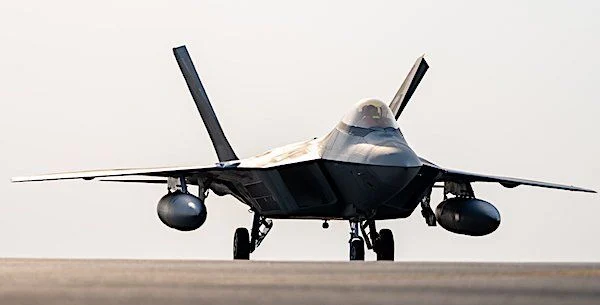
U.S. Air Force F-22 Raptors arrived in the U.S. Central Command area of responsibility Aug. 8, 2024, as part of U.S. force posture changes in the region to mitigate the possibility of regional escalation by Iran or its proxies.
| Published May 28, 2025
The article discusses the significant yet unofficial influence of internal Iranian opposition groups, particularly the People’s Mojahedin Organization of Iran (PMOI/MEK), on the country’s decision to engage in nuclear talks with the United States.
Key Points:
-
Internal Pressure on the Iranian Regime: Despite Supreme Leader Ali Khamenei’s public stance against negotiations with the U.S., internal factors, including widespread public discontent and the threat of uprisings, compelled the regime to reconsider.
-
Role of PMOI/MEK: The PMOI/MEK has been instrumental in organizing protests and resistance within Iran, leading to increased pressure on the government. Their activities have highlighted the regime’s vulnerabilities and the populace’s desire for change.
-
Impact on Nuclear Negotiations: The internal unrest and the potential for regime instability have influenced Iran’s approach to nuclear negotiations, making them more amenable to discussions and potential concessions.
-
External Threats and Diplomatic Dynamics: The article also touches on the external pressures from the U.S. and its allies, including the possibility of military action, which, combined with internal dissent, have pushed Iran towards the negotiating table.
The implications of Iran negotiating with the U.S. despite its leader’s public resistance are significant on multiple fronts:
1. Regime Vulnerability
The Islamic Republic’s willingness to negotiate signals internal weakness. It shows that opposition groups, economic unrest, and the threat of uprising have real influence over foreign policy—suggesting cracks in the regime’s control.
2. U.S. Leverage Strengthens
This shift validates the Trump administration’s pressure campaign. It implies that a hardline stance—sanctions, military posturing, and diplomatic isolation—can push even hostile regimes to the table when combined with internal resistance.
3. Empowerment of Iranian Opposition
Groups like PMOI/MEK gain credibility. Their efforts are now seen as directly influencing international diplomacy, possibly drawing more support from Western nations that had previously been cautious about backing regime opponents.
4. Geopolitical Recalibration
Other authoritarian regimes may take note: public defiance doesn’t guarantee long-term leverage. This could change how China, Russia, or North Korea approach their own balancing acts between ideology and pragmatism.
5. Risk of Escalation or Regime Collapse
If negotiations fail and the internal pressure continues to grow, Iran could spiral into deeper unrest—or even regime collapse. That creates both opportunities and dangers for regional and global stability.
Why is the Islamic republic talking to the U.S. when its supreme leader publicly claimed doing so is ‘neither rational nor honorable?’
Despite Iran’s Supreme Leader Ali Khamenei publicly denouncing negotiations with the U.S. as “neither rational nor honorable,” the regime is engaging in talks because of mounting internal pressure and fear of instability.
Here’s why:
1. Domestic Unrest
The Iranian regime is under severe internal strain. Economic hardship, widespread protests, and public dissatisfaction—exacerbated by international sanctions—have created intense pressure. Groups like the PMOI/MEK have fueled opposition and protests that the regime struggles to contain.
2. Survival Calculations
The regime may publicly reject talks to maintain ideological posture, but privately it recognizes that refusing all diplomacy could lead to even harsher sanctions, international isolation, or even conflict. Talking to the U.S. is seen as a way to relieve pressure without appearing weak—especially if done quietly or indirectly.
3. Strategic Flexibility
By keeping the Supreme Leader’s rhetoric hardline, the regime tries to save face at home while allowing negotiators to explore compromises abroad. This two-track strategy lets them adapt to shifting realities without openly betraying their ideological stance.
In short, they’re talking not because they want to—but because they have to.
Iran’s decision to engage in nuclear negotiations with the U.S., despite Supreme Leader Khamenei’s public defiance, reveals a classic case of authoritarian contradiction: ideology in front, survival behind. While the regime loudly rejects diplomacy to uphold revolutionary credibility, it quietly moves toward it to stave off collapse.
Broader Context:
-
Authoritarian Realpolitik
Like many authoritarian regimes, Iran walks a double line—sustaining hardline ideology for internal control while making pragmatic concessions to preserve power. This mirrors patterns in North Korea, Venezuela, and even late-stage USSR diplomacy. -
People’s Power as a Strategic Variable
The influence of opposition groups like PMOI/MEK—and the Iranian public’s economic despair—proves that internal resistance, even without formal political power, can shape foreign policy. It’s an emerging blueprint for how civil unrest forces autocratic recalibration. -
Shifting Power Centers in U.S. Foreign Policy
The Trump administration’s combination of maximum pressure and strategic ambiguity seems to be yielding movement—suggesting a revival of strength-based diplomacy. This could reshape U.S. leverage models in future dealings with rogue regimes like China and Russia. -
Global Implications
If the Islamic Republic is pushed to reform—or breaks under pressure—it will send ripples across the Middle East. It could embolden dissidents in Lebanon, Syria, and Iraq, where Iran’s influence is strong. Conversely, a cornered regime could grow more aggressive or unpredictable.
Final Insight:
This negotiation isn’t just about uranium enrichment—it’s about regime endurance, ideological identity, and the quiet but potent force of a suffering population. What plays out next could redefine Middle East power dynamics for a generation.
SOURCES: WORLD NET DAILY – The crucial but invisible player in Trump’s Iran nuclear negotiations





Be the first to comment